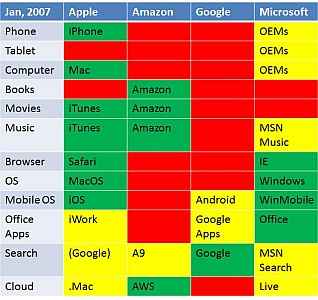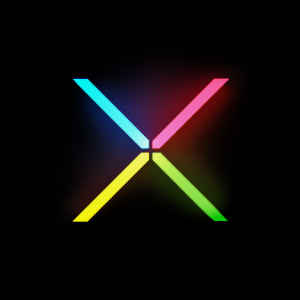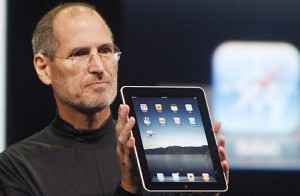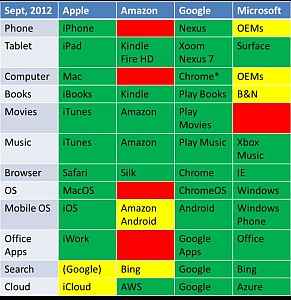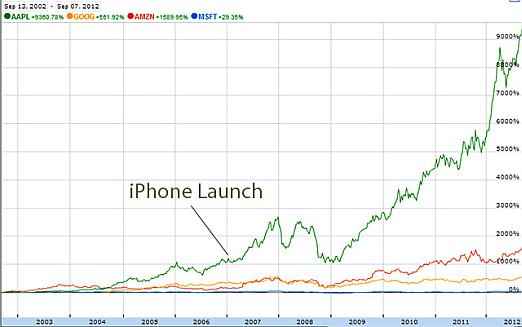Technological deathmatch: Amazon, Apple, Google and Microsoft face off

Combined, Amazon, Apple, Google and Microsoft represent over $1 trillion in company value. Most of that trillion dollars has been created in the past decade. For the first five of those years, each of the four had a clear playing field in its niche. Amazon selling books and other consumer goods, Apple selling stylish, user-friendly computers, Google selling search advertising, and Microsoft selling packaged software.
For the most part, there was an uneasy peace between the four companies. Fifteen years ago Microsoft even invested $150 million into a struggling Apple to help guarantee a market for its very profitable Office applications on Mac. For many years, Google’s then-CEO Eric Schmidt was happily ensconced on Apple’s board. One in ten iPods was sold on Amazon.com. Hardly friends, as evidenced by Amazon dumping Microsoft’s search engine, the companies didn’t feel obligated to foil each other at every opportunity.
The iPhone changed everything
A number of major technology shifts helped change this mutual wariness into all-out war. Convergence of traditional and digital media brought Apple’s iTunes head-to-head with Amazon. A drive to control user experiences through the browser and productivity applications brought Google into increasing conflict with Microsoft. Most of all, however, the iPhone launch crystallized the reality that all four of these titans of tech were after the same thing — the world’s eyeballs and consumer pocketbooks.
The state of play in 2007. Green means competitive offering, yellow is partner, partial or beta, red means no product in the space. The updated, 2012 table can be found on the next page.
Like the TV networks in their heyday, all of them began to worry about every move made by each other. Google quickly countered Job’s iPhone with Android-powered devices, and piled on with Chrome OS to hit Apple in what was then its core business. In addition to threatening to go “thermonuclear” over Android, Jobs ever so politely severed Apple’s relationship with Schmidt, saying ”Unfortunately, as Google enters more of Apple’s core businesses, with Android and now Chrome OS, Eric’s effectiveness as an Apple board member will be significantly diminished, since he will have to recuse himself from even larger portions of our meetings due to potential conflicts of interest.”
Google decides to sell stuff
Perhaps the most puzzling set of moves during this period was Google’s drive to enter nearly every possible digital market that Amazon, Apple or Microsoft were already in. Beginning with an awkward attempt to direct-sell the Nexus One in competition with Apple, Google also started pitching an application suite and a desktop OS to tweak Microsoft’s tail. More recently it’s gone after Amazon’s core offerings with a late-to-the-game content initiative — part of Google Play — and an obvious attempt to horn in on Amazon Web Services (AWS) with the Google Cloud initiative.
Aside from ensuring a hostile relationship with Amazon and Apple — Google was already at war with Microsoft — it’s not clear that its effort to press the battle onto the other firms’ home turf has paid off for Google. Picking these fights has gotten it thrown out as the Maps provider for both Apple and Amazon, and has resulted in Amazon increasingly distancing itself from Google’s Android branding and applications. With Google showcasing a “reinvented” Motorola as its hardware division, it is hard to blame them. Just recently rumors have surfaced that Amazon may try to muscle in on Google’s key OEM, Samsung, by licensing it the Amazon app store as a replacement for Android’s native Google Play services.
Amazon gets into the hardware business
When Amazon saw the writing on the wall that digital media would be the future, it was quick to cannibalize its own book business with the revolutionary Kindle platform and accompanying e-books. An instant hit, e-books looked like clear sailing for the retail giant — until Apple once again upset the proverbial apple cart with the introduction of the iPad.
Suddenly Amazon’s chokehold on digital media channels was endangered — not so much by the iPad hardware itself, but by Apple’s determination to control the user experience and revenue stream coming from every iOS device. Whether or not Amazon had ever pictured itself as a vendor of general-purpose computing devices, it scrambled to come up with the Kindle Fire product to protect its share of the digital media market.
Although a giant among the relative weak-selling field of Android tablets, the original Fire certainly didn’t put much of a dent in Apple’s mobile device juggernaut. It did provide a showcase for Amazon’s new Silk browser — another attempt to corral mindshare of its users, in this case away from Google’s Android browser. Amazon’s latest salvo, the Fire HD, brings it head to head with the iPad, where it hopes its aggressive pricing will gain it some traction.
Microsoft decides it wishes it was Apple
While Google, Apple, and Amazon made their aggressive moves out of fear and greed, Microsoft’s plunge into hardware can most easily be described as motivated by pure envy. Its OEM-based business model, and its stock price, have been stuck in a rut for over a decade. Despite massive revenues, profits, and marketshare, Microsoft has been increasingly marginalized by the growth of the web, and of mobile and cloud computing.
Taking matters into its own hands, Microsoft is making an aggressive investment in Nokia to guarantee a solid ally for Windows Phone 8. Stepping even further into its OEM’s turf, introducing the Surface tablets will ensure there is at least one flagship offering in the Windows tablet market.
Apple keeps on ticking
Unique among these companies, Apple always appears to be marching to its own drummer — even when introducing products that borrow heavily from others. The iPod was hardly the first digital music player. The iPhone drew on twenty years of stunted attempts to create all-in-one palm-sized devices. The iPad came nearly a decade after the Tablet PC and over twenty years after the first tablet. Yet each of Apple’s innovative products was unique enough, and complete enough, that it created a new market segment — dominated by Apple.
As exciting as the i* family of products has been, it won’t fuel Apple’s meteoric rise forever. Another “next big thing” needs to be on the horizon. TV is usually pointed to as the obvious choice. Here Apple has a chance to repeat its infuriating to competitors “late reinvention” strategy. Microsoft has fiddled with media and TV offerings for years without much luck — essentially abandoning its Media Center offering and finally selling off the last of its share of MSNBC. Google continues to flog its Google TV offering, but so far with very little real success.
If Tim Cook can pull off an alliance of content providers and cable companies, there is no doubt Apple has the technical expertise to create a world-beating product in the TV market. This will be his best chance to prove that he can really fill Steve Jobs’ shoes. Unless Microsoft pulls a rabbit out of the hat in the meantime with a competitive Xbox-based TV service, or Google has a breakthrough with Google TV, an amazing Apple TV product would put Apple back in the driver’s seat for years to come.
The state of play in 2012. As you can see, the battlefield has changed rather dramatically in just five years.
Who will be king of the hill?
Judging solely by market value, Apple is the undisputed winner of this melee so far. The $658 billion valuation that Wall Street places on AAPL is more than the total of $117 billion for AMZN, $232 billion for GOOG, and $258 billion for MSFT. In shareholder value there has been no contest over the last decade.
That doesn’t tell the whole story, however. Microsoft’s Steve Ballmer is quick to point out that Windows runs on over a billion devices, and expects Windows 8 to be on 500 million of them by the end of next year. Huge market share and over $70 billion in annual revenue give Microsoft plenty of runway to push its new, unified Windows 8 initiative. If it is right that users want the same platform across all their devices, Windows 8 may be the perfect product.
Google has its own monster-sized assets. The internet’s most ubiquitous brand, Google search has hardly been dented by competition, and YouTube has more than justified its initial eye-opening purchase price. Android doesn’t help Google’s bottom line, but with over half of the worldwide market for smartphones it represents a huge opportunity for add-on content and services.
Despite its runaway success with the Kindle and Amazon Web Services, Amazon is a relative newcomer to the high-tech market. Its increasing presence in every segment of online retailing give it a $50 billion core business and fierce customer loyalty to use in fueling its foray into consumer electronics. For all that recent rumors of an Amazon-branded phone were unfounded, it seems inevitable that Amazon will move in that direction now that it is already competing head-to-head with Google and Apple.
Unlike broadcast TV networks, car companies, and airlines, it is unusual for a high-tech market to have several similarly-sized competitors for long. More normal is the Windows-Mac or Intel-AMD split, where the lion’s share of the market and the profits go to one firm. In mobile devices that has been Apple, in web advertising that has been Google, in online retail it’s been Amazon, and in software it’s been Microsoft. If those markets continue to converge, only one leader will emerge. A trillion dollars in company value rides on which of them wins out.
Copyright © 2010 Ziff Davis Publishing Holdings Inc


